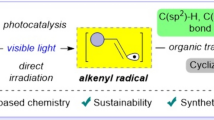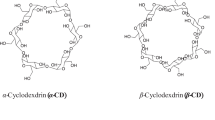Abstract
Two new o-hydroxycinnamates have been prepared for photoremovable protecting groups, and their photochemistry has been investigated. The photolysis of two caged compounds can efficiently release the corresponding alcohol in aqueous solutions, and the uncaging reaction proceeds with large one-photon excitation cross sections (1919 and 1535 M-1 cm-1). The uncaging process has been observed by NMR spectroscopy. The caged compounds exhibit good aqueous solubility and excellent resistance to hydrolysis in a buffer solution.
Similar content being viewed by others
Notes and references
G. Mayer and A. Heckel, Biologically active molecules with a “light switch”, Angew. Chem., Int. Ed., 2006, 45, 4900–4921.
A. P. Pelliccioli and J. Wirz, Photoremovable protecting groups: reaction mechanisms and applications, Photochem. Photobiol. Sci., 2002, 1, 441–458.
C. G. Bochet, Photolabile protecting groups and linkers, J. Chem. Soc., Perkin Trans. 1, 2002, 125–142.
D. E. Falvey and C. Sundararajan, Photoremovable protecting groups based on electron transfer chemistry, Photochem. Photobiol. Sci., 2004, 3, 831–838.
J. P. Casey, R. A. Blidner and W. T. Monroe, Caged siRNAs for spatiotemporal control of gene silencing, Mol. Pharmaceutics, 2009, 6, 669–685.
O. D. Fedoryak and T. M. Dore, Brominated hydroxyquinoline as a photolabile protecting group with sensitivity to multiphoton excitation, Org. Lett., 2002, 4, 3419–3422.
Y. Zhu, C. M. Pavlos, J. P. Toscano and T. M. Dore, 8-Bromo-7-hydroxyquinoline as a photoremovable protecting group for physiological use: mechanism and scope, J. Am. Chem. Soc., 2006, 128, 4267–4276.
A. P. Kostikov and V. V. Popik, 2,5-Dihydroxybenzyl and (1,4-dihydroxy-2-naphthyl)methyl, novel reductively armed photocages for the hydroxyl moiety, J. Org. Chem., 2007, 72, 9190–9194.
A. Kulikov, S. Arumugam and V. V. Popik, Photolabile protection of alcohols, phenols, and carboxylic acids with 3-hydroxy-2-naphthalenemethanol, J. Org. Chem., 2008, 73, 7611–7615.
L. Zhou, H. Yang and P. F. Wang, Development of trityl-based photolabile hydroxyl protecting groups, J. Org. Chem., 2011, 76(15), 5873–5881.
V. Hagen, S. Frings, J. Bendig, D. Lorenz, B. Wiesner and U. B. Kaupp, Fluorescence spectroscopic quantification of the release of cyclic nucleotides from photocleavable [bis(carboxymethoxy) coumarin-4-yl]methyl esters inside cells, Angew. Chem., Int. Ed., 2002, 41, 3625–3628.
V. Hagen, B. Dekowski, V. Nache, R. Schmidt, D. Geißler, D. Lorenz, J. Eichhorst, S. Keller, H. Kaneko, K. Benndorf and B. Wiesner, Coumarinylmethyl esters for ultrafast release of high concentrations of cyclic nucleotides upon one- and two-photon photolysis, Angew. Chem., Int. Ed., 2005, 44, 7887–7891.
V. Hagen, F. Kilic, J. Schaal, B. Dekowski, R. Schmidt and N. Kotzur, [8-[Bis(carboxymethyl)aminomethyl]-6-bromo-7-hydroxy coumarin-4-yl] methyl moieties as photoremovable protecting groups for compounds with COOH, NH2, OH, and C•O Functions, J. Org. Chem., 2010, 75, 2790–2797.
D. Turner, S. V. Pizzo, G. Rozakis and N. A. Porter, Photoreactivation of irreversibly inhibited serine proteinases, J. Am. Chem. Soc., 1988, 110, 244–250.
H. Li, J. H. Yang and N. A. Porter, Preparation and photochemistry of o-aminocinnamates, J. Photochem. Photobiol., A, 2005, 169, 289–297.
N. Gagey, P. Neveu, C. Benbrahim, B. Goetz, I. Aujard, J. B. Baudin and L. Jullien, Two-photon uncaging with fluorescence reporting: evaluation of the o-hydroxycinnamic platform, J. Am. Chem. Soc., 2007, 129, 9986–9998.
N. Gagey, M. Emond, P. Neveu, C. Benbrahim, B. Goetz, I. Aujard, J. B. Baudin and L. Jullien, Alcohol uncaging with fluorescence reporting: evaluation of o-acetoxyphenyl methyloxazolone precursors, Org. Lett., 2008, 10, 2341–2344.
N. Gagey, P. Neveu and L. Jullien, Two-photon uncaging with the efficient 3,5-dibromo-2,4-dihydroxycinnamic caging group, Angew. Chem., Int. Ed., 2007, 46, 2467–2469.
M. G. Thomas, C. Lawson, N. M. Allanson, B. W. Leslie, J. R. Bottomley, A. McBride, O. A. Olusanya and L. PanTherix, A series of 2(Z)-2-benzylidene-6,7-dihydroxybenzofuran-3[2H]-ones as inhibitors of chorismate synthase, Bioorg. Med. Chem. Lett., 2003, 13, 423–426.
Z. J. Gao, D. J. Maloney, L. M. Dedkova and S. M. Hecht, Inhibitors of DNA polymerase: activity and mechanism, Bioorg. Med. Chem., 2008, 16, 4331–4340.
H. Yang, J. J. Chen, P. Zhao, H. B. Lv, Y. Yu, P. Y. Xu and J. L. Zhang, Luminescent zinc salen complexes as single and two-photon fluorescence subcellular imaging probes, Chem. Commun., 2010, 47, 2435–2437.
J. N. Demas and G. A. Crosby, The measurement of photoluminescence quantum yields. A review, J. Phys. Chem., 1971, 75, 991–1001.
S. L. Murov, I. Carmichael and G. L. Hug, Handbook of Photochemistry, Marcel Dekker Inc., New York, 2nd edn, 1993.
R. Hershfield and G. L. Schmir, The lactonization of ring-substituted coumarinic acids. Structural effects on the partitioning of tetrahedral intermediates in esterification, J. Am. Chem. Soc., 1973, 95, 7359–7369.
R. Hershfield and G. L. Schmir, Lactonization of coumarinic acids. Kinetic evidence for three species of the tetrahedral intermediate, J. Am. Chem. Soc., 1973, 95, 8032–8040.
Author information
Authors and Affiliations
Corresponding author
Rights and permissions
About this article
Cite this article
Duan, XY., Zhai, BC. & Song, QH. Water-soluble o-hydroxycinnamate as an efficient photoremovable protecting group of alcohols with fluorescence reporting. Photochem Photobiol Sci 11, 593–598 (2012). https://doi.org/10.1039/c2pp05309h
Received:
Accepted:
Published:
Issue Date:
DOI: https://doi.org/10.1039/c2pp05309h




